A Floating Boaters' Mecca
By Ann E. Dorbin
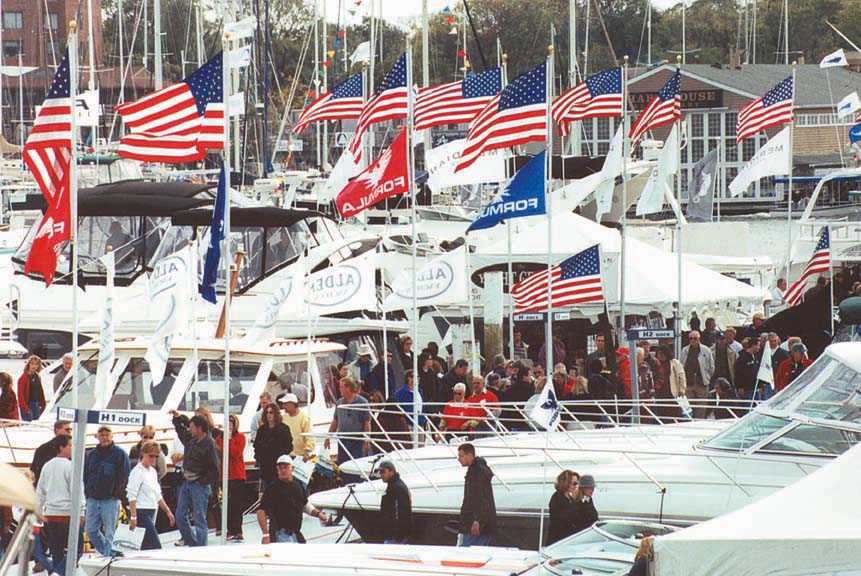
It's the October weekend before Columbus Day, and that can mean only one thing to Annapolis: Welcome to the Greatest Show on Water.
Since they began in 1970, the Annual Sail and Power Boat Shows have created the largest single event to occur at City Dock. For two weeks, Ego Alley is transformed into an international marine festival and the premier in-the-water show in the country, attracting an average of 100,000 attendees per year. Record crowds come to look over boats proclaimed to be the biggest, fastest, most luxurious, most fun . . . in short, the very best that boating has to offer. For manufacturers and suppliers, the boat show is a major date. "If you're not here, you're not a player," says yacht broker, Jay Lebow. Mike Lechelop from Beneteau Yachts agrees. "There is no comparison to this show and the others. It signals the start of the new model year and draws a crowd that really makes it an event." Through hurricanes, floods, recessions, and national disasters, the shows have continued for well over three decades.
"My most vivid memory is trying to sell daysailors in a snowstorm during the Sailboat Show in '76 or '77," says John Byrnes, an exhibitor from Tri-State Marine in Deale, Maryland who has worked the shows since 1974. "Driving past the sand bags and military installations at the Naval Academy just after 9-ll was also impressive. Not a good background for people to spend money; but as it worked out, it was the best show ever. The Annapolis Boat Shows are always great to work. You're outside and most everyone is in a great mood . . . plus most of them played hooky from work."
With hundreds of boats on display-both floating and dry docked-and dozens of exhibitors from around the world set up under acres of tenting, not only are the Boat Shows a lot of fun, but they generate gross sales of boats, merchandise, and accessories in the hundreds of millions of dollars, constituting a mainstay event for Annapolis, the Chesapeake Bay region, and Maryland's marine industry.
IN THE BEGINNING . . .
A RADICAL IDEA
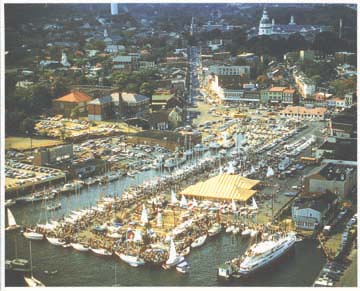 But it wasn't always that way. For one thing, although it might seem as obvious as an Eskimo selling ice, in the 1960s the concept of an in-the-water boat show was a radical one. When founders Jerry Wood and Peter J. Carroll launched the first event in February 1970, exhibiting 51 sailboats, skeptics said the idea would never take off. But it wasn't always that way. For one thing, although it might seem as obvious as an Eskimo selling ice, in the 1960s the concept of an in-the-water boat show was a radical one. When founders Jerry Wood and Peter J. Carroll launched the first event in February 1970, exhibiting 51 sailboats, skeptics said the idea would never take off.
Jerry Wood was also the owner of the Annapolis Sailing School, the largest sailing school in the United States. His idea for an in-the-water boat show began with his dissatisfaction with the Washington Boat show as a means of promoting the school. Those days, boat shows were held indoors in the wintertime. Wood realized that an auditorium in the dead of winter was a less-than-ideal venue for promoting sailing's sunny romance. What the show-goer needed, Wood believed, was to see boats in their natural element: in the water.
It was an idea he began formulating as early as 1963. The idea jelled when Peter Carroll, who was in the business of promoting home and leisure shows, met Wood while taking sailing lessons. In 1970, the two men put together the first U.S. Sailboat Show at the Annapolis inner harbor. Two things made the show unusual: it was held in the water and in the fall. These two seemingly simple components were to prove revolutionary in the marine industry.
Traditionally, boat shows had been held in the winter months to kindle boat-buying enthusiasm just before the start of the spring boating season. But at the time there were two problems with winter shows. One was that high demand could cause delays in summer delivery; the other was when boats were introduced at winter shows and sold during spring and early summer, the industry slowed for much of the year. Beginning in the late 1960s, one way manufacturers attempted to fill slack time was to keep pushing up production schedules so that by late summer new models were ready to show. Then they anxiously waited for the winter shows to roll around. The late 1960s also marked a rapidly growing popularity in the sport of sailing. As the sport grew, so did the sailing industry-boatbuilders, equipment manufacturers, sailmakers. And as the industry expanded, it grew increasingly uncomfortable with winter shows.
PERFECT TIMING
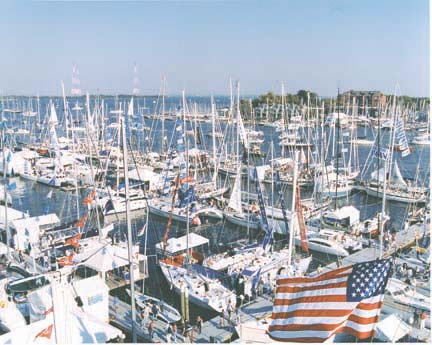 The writing was on the wall for in-water shows. In his article in the October 1979 issue of Sail magazine, Bob Payne wrote that, "A combination of everyone else dragging his feet or being too distant to gain strong support from East Coast builders, and Annapolis being a beautiful town in the center of a large sailing population allowed Wood and Carroll to capture the enthusiasm of the sailing industry." The writing was on the wall for in-water shows. In his article in the October 1979 issue of Sail magazine, Bob Payne wrote that, "A combination of everyone else dragging his feet or being too distant to gain strong support from East Coast builders, and Annapolis being a beautiful town in the center of a large sailing population allowed Wood and Carroll to capture the enthusiasm of the sailing industry."
James Barthold, the shows' general manager since the mid-1970s, says, "The marine industry had matured enough that the idea of an in-the-water show made sense. The timing was perfect for an industry ready to break out."
Payne attributed the most significant factor in their success to the fact that the show was held in the fall. The timing allowed manufacturers to show new models sooner, allowing more time for spring delivery and reducing transportation costs since boats could be brought in by water rather than being trucked overland. "We can say we are the greatest marketing geniuses in the world," Wood said of the timing, "or we can say it was a simple fact of that's when the weather is best in Annapolis. The weather seemed to be the best certainty for what at the time was a most precarious enterprise." (More than once, high tides have pushed water into the tents used by gear and equipment manufacturers, making them more a part of the "in-the-water" experience than they wished to be; yet, organizers say it has proved to be more "waterproof" than originally expected.)
The following fall, partly because of the success of Annapolis and partly because the timing was right, three new all-sail in-the-water shows opened in Newport, Clemens MI, and Los Angeles. Each following year, the fever grew until manufacturers were sending their products and reps around to as many as 14 or 15 shows. The successful fate of flotilla-style marketing was sealed as power boat shows soon followed in Annapolis, Stamford, CT; Norwalk, CT, Sandusky, OH, Miami, and Houston. Compared to the sailing's rapid growth spurt, Barthold says powerboat shows were an "inverted experience," evolving more gradually until they reached equal status with sailboat shows.
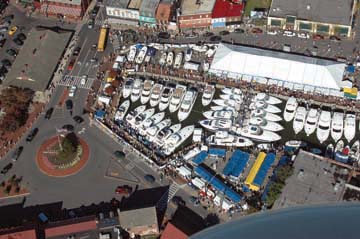 As the first flush of boating fever subsided, periods of flux, characterized by reassessment and adjustment, naturally occurred. Manufacturers have come and gone, some shows have not survived, and others have become more regional. Over the years, the kinds of buyers and boats that come to the Annapolis shows have also changed. "In the early years, the shows were more heavily attended by small-boat people. But these buyers became unwilling to commit in the fall to a boat they knew they can buy off the shelf in the spring. Thus, larger boats, in the 30 to 60-foot range now dominate. The largest boat to date measured 90-feet; the highest priced ones go for millions of dollars." As the first flush of boating fever subsided, periods of flux, characterized by reassessment and adjustment, naturally occurred. Manufacturers have come and gone, some shows have not survived, and others have become more regional. Over the years, the kinds of buyers and boats that come to the Annapolis shows have also changed. "In the early years, the shows were more heavily attended by small-boat people. But these buyers became unwilling to commit in the fall to a boat they knew they can buy off the shelf in the spring. Thus, larger boats, in the 30 to 60-foot range now dominate. The largest boat to date measured 90-feet; the highest priced ones go for millions of dollars."
Boat Show owner Jerry Wood's idea was radical, all right. Setting an example for similar boat shows throughout the world, it changed the way the boating industry would market its product and introduce and display new models from then on.
FROM CONCEPT
TO TRADITION
Once the annual Annapolis shows became established, the scope of the event snowballed. It was not unusual to see 550 sailboats and 350 powerboats at the shows. Today, these numbers have evened out to about 250 boats per sailboat show and 500 per powerboat show. The shows' international reach, high attendance, impact on the local economy, and key significance in the national marine industry (as well as those of traffic congestion, parking challenges, and scarcity of accommodations), indicate continued strength and popularity.
Barthold points out that the location of "America's Sailing Capital" within the Baltimore-Washington-Richmond "megalopolis" has provided a huge population base and tourist draw. He emphasizes the critically important factors of enjoying a good relationship with the City of Annapolis and running an event driven by a dedicated operations team. He says the shows' staff of full- and part-time employees, most of whom have worked the venue for many years, are well-suited for a complex task, and "constitute the shows' intellectual property."
CRUNCHING
THE NUMBERS
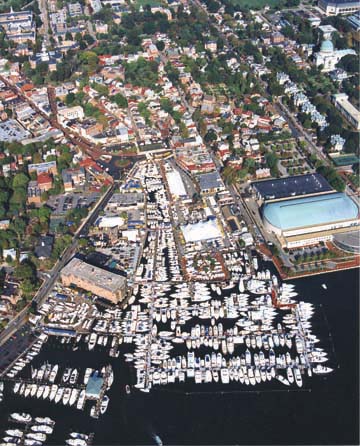 The Boat Shows are an important factor in Maryland's economy. In recent years, the industry has come to swing considerable economic weight. The U.S. Sail and Powerboat Shows represent the health of an industry that has an annual economic impact of $1.6 billion (including transient boaters) or more in the state, contributing a similar portion of the state's gross state product as the agricultural industry. The Boat Shows are an important factor in Maryland's economy. In recent years, the industry has come to swing considerable economic weight. The U.S. Sail and Powerboat Shows represent the health of an industry that has an annual economic impact of $1.6 billion (including transient boaters) or more in the state, contributing a similar portion of the state's gross state product as the agricultural industry.
"The Boat Shows and Maryland's marine industry came of age together," says Barthold. "It was a symbiotic relationship. The marine industry wouldn't have been the same without the Boat Shows to help it grow, and the shows wouldn't have grown without a marine industry that was prepared to grow along with it."
The Annapolis Boat Shows also generate considerable business for other areas of the economy.
Each show itself spends substantial sums locally. Strictly a Maryland operation, all of the show employees and contractors are drawn from the area. "We don't bring in people who make their money and then leave the state with it," Barthold says. "All that is spent is spent on the local economy."
Every year the two-week event creates a local boom that area merchants have come to count on.
Hotels, restaurants, bars, and shops all put on extra staff and extend their hours to accommodate the thousands of people the shows attract. Boat show time is also a tremendously profitable, if frantic, time for Bay area boat dealers and yacht yards that must get the hundreds of boats ready for display, commissioning as many as fifteen boats a day. Boat cleaning services average 30 or 40 boats a week as the opening day of the show approaches.
BREAKING UP IS
HARD TO DO...
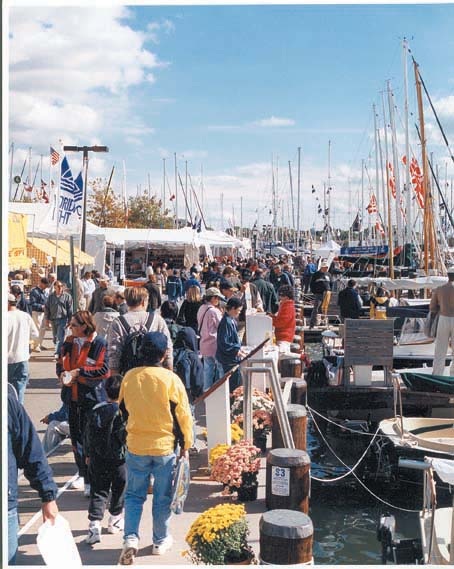 It takes three crews working three double shifts to erect the floating nomad city that magically transforms the City Dock into a mass of sailboats at the event opening. The setup and breakdown for the shows is a crowd-pleasing logistical tour de force that has been described as "an operation of nautical choreography that must be seen to be believed." A temporary city, held together by thousands of bolts-all checked and double-checked-sprawls out of the City Dock into Spa Creek, replete with its own electrical and telephone system, elevated floating docks (to help prevent flooding), newly-driven pilings, bridges, and hundreds of newly-constructed boat slips waiting to receive spanking-new boats from around the world. A mini-city of tents, trailers, and outdoor land displays springs up around the harbor. "The way the shows go together is like an enormous real life puzzle that goes together in numbered pieces," Barthold says. It takes three crews working three double shifts to erect the floating nomad city that magically transforms the City Dock into a mass of sailboats at the event opening. The setup and breakdown for the shows is a crowd-pleasing logistical tour de force that has been described as "an operation of nautical choreography that must be seen to be believed." A temporary city, held together by thousands of bolts-all checked and double-checked-sprawls out of the City Dock into Spa Creek, replete with its own electrical and telephone system, elevated floating docks (to help prevent flooding), newly-driven pilings, bridges, and hundreds of newly-constructed boat slips waiting to receive spanking-new boats from around the world. A mini-city of tents, trailers, and outdoor land displays springs up around the harbor. "The way the shows go together is like an enormous real life puzzle that goes together in numbered pieces," Barthold says.
Four days after the Sailboat Show opens, at precisely 5 p.m. on Columbus Day, an announcement hailing the end of the country's largest in-the-water sailboat show bellows through the public-address system. In an exquisitely timed do-si-do, a 45-minute transformation called "the stuff of legends" and aptly described as a "metamorphosis. something like watching a real-life stage of time-lapse photography," boat show crew and exhibitors alike display finesse honed over 30 years as they proceed to ship out two hundred and fifty masted yachts and replaced them with sparless, powerboats that have been circling like sharks as they wait for their moorings to be vacated. This show-within-a-show has become a spectator sport with an audience of fans enthusiastically cheering from the surrounding docks, sidewalks, and balconies.
A week later, at the end of the Power Boat Show, the City Dock is returned to its normal state, right down to replacing damaged paving bricks from a supply kept just for that purpose. Even more quickly than it was put together, the show comes to an end. But in just a matter of weeks, leasing negotiations will begin and new brochures will be sent out, lining up exhibitors for next year, when the spectacle begins again.
Back
|

